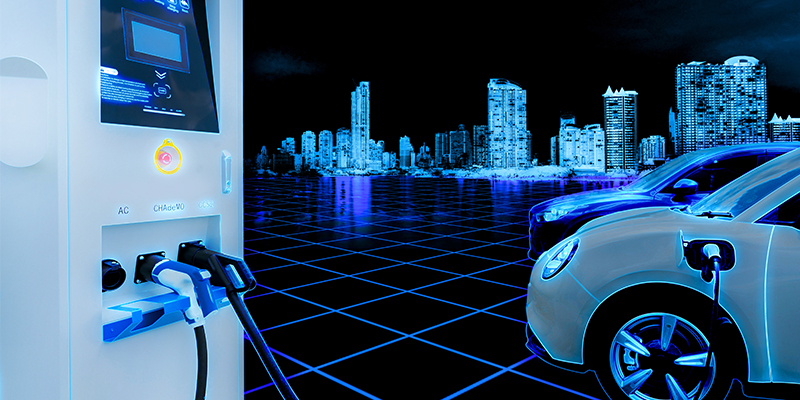Electric vehicle (EV) use is accelerating, and commercial real estate owners can reap significant benefits from installing EV charging infrastructure at their properties. A recent NAIOP webinar explained how EV charging station implementation can attract and retain tenants, improve the property’s environmental score and generate new revenue streams.
According to Bryce Christensen, P.E., a senior partner with Kimley-Horn, EVs are becoming more affordable. Of the more than 40 options currently on the market, he said that 10 now cost under $40,000, and nearly every major automaker made public commitments to EVs, which should boost adoption by helping bring prices down even more.
“It’s no secret that the market share of electric vehicles in the United States and worldwide is trending up,” Bryce said. “The demand is rising, and many potential consumers are just waiting for more charging infrastructure before committing to going all electric.”
Bryce noted that the tipping point for accelerated adoption of EVs seems to be around 5% market share, based on data from BloombergNEF.
“Typically, the first 5% market share is the slowest to achieve,” Christensen said. “But once you get to 5%, EVs can quickly go from niche to mainstream.”
For example, Norway currently leads the world in EV adoption rates. In 1990, the Norwegian government implemented a temporary tax exemption to incentivize EVs. It took until 2013 for the country to hit 5% adoption, but today, EVs account for more than 20% of all passenger vehicles on the road in the country, and more than 80% of all new vehicles sold.
According to Christensen, the U.S. market share for EVs reached 5.6% in the second quarter of this year.
Charging Basics
Jessica Cain, P.E., a senior partner with Kimley-Horn, discussed the different charging levels available for EVs.
Level 1 charging has power requirements similar to a toaster.
“You can run an extension cord and plug it right in to your kitchen counter and in about 10 minutes, you can drive about a mile,” she said.” In several days, you’ll have a fully charged battery. So while it is an option, it probably isn’t too practical for most of us.”
Level 2 chargers, with power requirements similar to a clothes dryer, can fully charge a car in about eight to 13 hours.
Level 3 chargers, also called DC fast chargers, have the potential to fully charge a vehicle in about 20 minutes. They also have the greatest power consumption, with requirements equaling five to 10 central air conditioners.
Use Case
The first step in setting up the ideal EV charging solution is understanding the use case:
- Consider the types of vehicles that will be charged, the types of drivers who will use the facility, and the goals of the site owners.
- Determine if the chargers will be open to the public or reserved for private users only.
- Evaluate the dwell time of vehicles at the charging location, which can vary significantly depending on the purpose of the site. For example, if the site is a destination charging stop where travelers need a quick charge before continuing their journey, a Level 3 DC fast-charging solution may be suitable. Conversely, if the site is a hotel where vehicles are parked for an extended period, a Level 2 charger might be more appropriate.
- Think about additional features such as smart monitoring, payment capabilities, credit card readers, cellular or Wi-Fi connections, and data collection for sustainability reports.
Site Characteristics
Analyzing the site’s physical characteristics is another critical aspect of successful EV charging station implementation:
- Assess available electrical capacity and whether it’s feasible to bring in more power if needed.
- Consider charging station placement, site accessibility and drainage patterns.
- Verify whether the site is in a floodplain and if it meets accessibility standards for public-facing charging.
- Station visibility is also important. While charging stations can usually be found by EVs seeking them out with GPS, having some visibility to the charging station can be good for public relations and safety for the users.
Business Models
Understanding different business models for EV charging is crucial as it can influence investment and revenue opportunities. There are several options, such as leasing the site to network operators who handle the infrastructure investment, equipment and maintenance. In return, they might pay rent or offer a revenue-sharing solution based on usage.
Alternatively, some landlords own and maintain the EV charging equipment. While this option requires upfront costs, it offers more control over the charging rates, access to customer data and additional revenue opportunities, such as contracting with nearby fleet customers.
Grants and Funding
Federal and state grants and funding opportunities aimed at promoting EV adoption and infrastructure development provide major incentives for installing charging stations. For example, the $1.2 trillion Infrastructure Investment and Jobs Act includes provisions for EV charging network development and emissions reductions. Additionally, specific programs include the $5 billion National Electric Vehicle Infrastructure Formula Program, which is working to develop a national DC fast-charging network, and the $2.5 billion Community and Fueling Infrastructure (CFI), a discretionary grant program that will be open to cities, counties, local municipalities and tribes. The CFI program also includes carve-outs for battery storage and solar to support infrastructure development.
It’s essential to research and identify the various funding sources and incentives that are locally available to offset the installation costs and ensure the viability of any EV charging project.
Environmental and Business Benefits
Investing in EV charging stations offers several benefits to a company. Beyond the potential revenue streams, implementing charging infrastructure helps meet sustainability objectives and differentiate the property. As companies increasingly adopt sustainability goals, offering EV charging facilities becomes a strategic advantage that aligns with the growing demand for environmentally responsible practices.
“We’ve seen many of the largest corporations in America make public sustainability goals,” Christensen said. “They have to find ways to achieve these. Lots of different things come into play. And differentiating your location with EV charging is a great way to attract customers, tenants and future investors.”
NAIOP members can listen to the full recording (available for 30 days) online.














